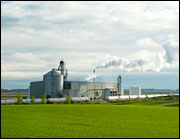
Of all the arguments in favor of government backing for corn-based ethanol, only one seems even remotely reasonable to me: that it could lead to real economic development in depressed areas of the Midwest.
The theory goes like this: When farmers pool resources and build their own ethanol plants, they’ll capture much higher profits than by merely selling corn to big buyers like ADM and Cargill. According to an article in today’s Wisconsin State Journal, that rationale for corn-based ethanol may be about to unravel.
For about two generations, the Midwest’s farmers have seen the price for corn and other grains steadily drop. While their profit margins eroded — and often turned negative, prompting massive government subsidies — they had to watch as their buyers, mainly Archer Daniels Midland and Cargill, turned all that cut-rate grain into highly profitable products.
In the mid-1990s, farmers began to form cooperatives and invest in ethanol plants. Rather than sell their corn to ADM, the thinking went, why not "add value" to it themselves, and capture a slice of the profits that are typically reserved for ADM shareholders?
That thinking led to a boom in farmer-owned ethanol cooperatives. By 2002, David Morris of the Institute for Local Self-Reliance reports, 25,000 farmers owned shares in ethanol plants. Collectively, farmer-owned facilities produced more ethanol than Archer Daniels Midland, the Exxon of corn.
But then a funny thing happened. With the 2005 Energy Policy Act, President Bush dramatically boosted the federal mandate for "renewable fuel" use in the nation’s auto-fuel supply. Corn-based ethanol, which had enjoyed steady government support since the 1970s, was the only "renewable fuel" produced in any substantial quantity. The big new mandate, along with the phaseout of MTBE as a gasoline additive, caused a nearly instant stampede of Wall Street and corporate cash into ethanol production.
In January 2005, the Renewable Fuels Association informs us, there were 81 ethanol plants operating in the U.S., and 16 under construction. Then Bush rolled out his ethanol plan. By January 2006, 95 plants were in operation, with 31 under construction. Today, there are 119 plants going, and a stunning 86 under construction. In other words, there are now more ethanol plants under construction than there were plants in existence as recently as 2005.
The great bulk of these new projects are owned not by farmers but by well-capitalized corporations and Wall Street-financed investment enterprises. And according to economists quoted in the Wisconsin State Journal, these entities are very likely to squeeze out the farmer-owned facilities that rose up in the 1990s and early 2000s. That’s because all the new ethanol plants rushing online are glutting the market with product, driving down the ethanol price. And it will likely be the big, well-capitalized plants that will survive a glut — likely at the expense of smaller, farmer-owned facilities.
James Williams, an energy economist with WTRG Energy Economics of London, Ark., tells the Journal to expect "fire sales" by small, farmer-owned plants that can’t produce as cheaply as their bigger, newer competitors. "What you will see is a lot of these small mom-and-pop things being bought by larger concerns over the next five years," Williams said.
David Swenson, an ag economist at Iowa State, echoes Williams. "Plants with much better scale of economies are going to be in much better position perhaps than some of these older plants," he says.
If the ethanol industry does consolidate and fall into corporate hands, farmers in the Midwest will be right back where they started from: selling cheap grain to a few big corporate buyers, and watching them turn it into fat profits for their shareholders. I can’t say I’ll be surprised. (Full disclosure: I first predicted such a fate back in April 2005.)
There was always a tragic flaw in the ethanol-as-rural-development idea: Ethanol, like industrially produced corn, is a commodity. A gallon of ethanol produced by a farmer-owned plant is identical to a gallon produced by ADM or one produced by a Wall Street consortium.
And in commodity markets, the biggest producers nearly always devour their smaller competitors. And just as sharks don’t consult their prey before the jaws snap shut, big commodity players don’t show pity or nostalgia when they take over the small fry.
The consolidation of commodity markets is not a pretty spectacle — unless you own shares in one of the winning firms.


